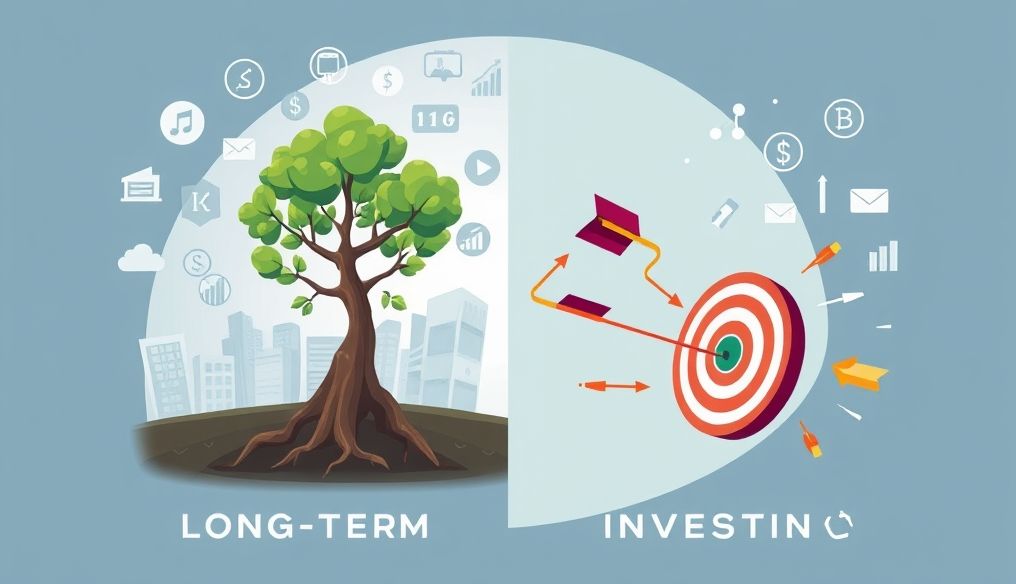Introduction: Investing - A Journey Towards Achieving Financial Goals
Investing is a long-term journey that requires careful planning and a deep understanding of market tools. Investors always face a crucial choice: should they opt for long-term or short-term investing? Both strategies have their advantages and disadvantages, and the best choice depends on financial goals, risk tolerance, and the personal financial situation of each investor.
Chapter 1: Defining Long-Term and Short-Term Investing
What is Long-Term Investing?
Long-term investing is a strategy aimed at achieving returns over a long period, usually more than five years, and often extending for decades. Investors focus on the gradual growth of capital by investing in assets expected to increase in value over time, such as stocks, real estate, and government bonds.
What is Short-Term Investing?
Short-term investing is a strategy aimed at achieving quick returns within a short period, typically less than three years. Investors focus on liquid assets that can be converted into cash quickly, such as high-yield savings accounts, money market funds, and short-term certificates of deposit.
Chapter 2: Advantages and Disadvantages of Long-Term Investing
Advantages:
- Potential for Higher Returns: Historically, stocks and real estate have delivered higher long-term returns compared to short-term assets.
- Benefit from the Power of Compounding: Reinvesting earnings allows capital to grow at an accelerated pace over time.
- Hedge Against Inflation: Long-term assets tend to maintain or increase their value as inflation rises.
- Capitalizing on Market Volatility: Investors can buy assets at low prices during downturns and hold them until the market recovers.
Disadvantages:
- Long Waiting Period: Achieving financial goals may take a long time.
- Market Volatility: Investment values can experience significant fluctuations in the short term.
- Need for Patience and Discipline: Long-term investing requires commitment to the plan and avoiding panic when prices fall.
Chapter 3: Advantages and Disadvantages of Short-Term Investing
Advantages:
- Liquidity: Assets can be converted into cash quickly when needed.
- Safety: Short-term assets are less susceptible to market fluctuations.
- Flexibility: Investors can easily adjust their strategy in response to market changes.
Disadvantages:
- Lower Returns: Returns are typically lower than long-term investments.
- Inflation Impact: Short-term assets may not maintain their value as inflation rises.
- Higher Taxes: Short-term gains may be subject to higher taxes than long-term gains.
Chapter 4: Factors Determining the Appropriate Strategy
Choosing the right strategy depends on several factors, including:
- Financial Goals: What goals are you trying to achieve through investing? (e.g., retirement, buying a home, children's education)
- Time Horizon: When do you need access to your funds?
- Risk Tolerance: What level of risk are you willing to take?
- Personal Financial Situation: What is your income, expenses, and financial obligations?
Chapter 5: Examples of Long-Term Investments
- Stocks: Shares in the ownership of companies, offering the potential for high returns but carrying high risk.
- Real Estate: Purchasing properties with the aim of renting them out or selling them later at a higher price.
- Government Bonds: Loans provided by the government to investors with a fixed interest rate, considered less risky than stocks.
- Mutual Funds: Diversified investment portfolios managed by specialized companies.
- Investing in Gold and Precious Metals: Considered a safe haven during economic crises.
Chapter 6: Examples of Short-Term Investments
- High-Yield Savings Accounts: Accounts offering higher interest rates than traditional savings accounts.
- Money Market Funds: Funds that invest in short-term debt instruments.
- Short-Term Certificates of Deposit: Bank deposits for a fixed period with a fixed interest rate.
- Treasury Bills: Short-term government debt instruments.
Chapter 7: Diversification Strategies to Reduce Risk
Diversification is spreading investments across a variety of assets to reduce risk. Diversification can be achieved by investing in:
- Different Asset Classes: (Stocks, bonds, real estate, commodities).
- Different Sectors: (Technology, healthcare, energy).
- Different Geographical Regions: (Domestic and international markets).
Chapter 8: The Role of a Financial Advisor
A financial advisor can provide professional advice on how to choose the investment strategy that is right for your goals and financial circumstances. A financial advisor can also help you build a diversified investment portfolio and manage risk.
Chapter 9: Common Mistakes to Avoid
- Investing Based on Emotions: Making investment decisions based on fear or greed.
- Trying to Time the Market: Trying to predict market movements to buy and sell assets at the right time.
- Lack of Diversification: Putting all your eggs in one basket.
- Not Reviewing the Investment Portfolio Regularly: The investment portfolio should be reviewed regularly to ensure it is still aligned with your goals and financial circumstances.
Chapter 10: Practical Tips for Investors
- Clearly Define Your Financial Goals: What do you want to achieve through investing?
- Research Appropriate Investments: Before investing in any asset, conduct thorough research.
- Be Patient and Disciplined: Investing is a long-term journey, and do not expect quick profits.
- Consult a Financial Advisor: If you are unsure of how to get started, seek help from a qualified financial advisor.
Disclaimer: This article is for informational purposes only and should not be considered financial advice. Consult a financial advisor before making any investment decisions.




